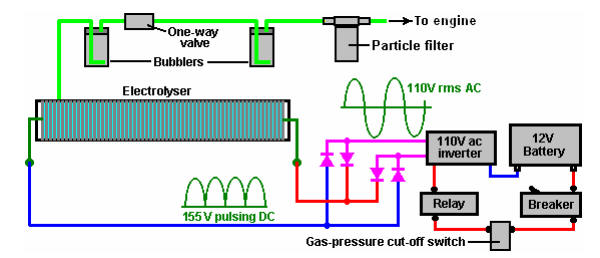|
Bob Boyce Dry Cells
It is possible to produce large volumes of hydroxy gas from a DC hydrogen generator; enough gas to run a small motor
directly on it. In order to do so, we need to pay attention to the
efficiency factors. Bob Boyce is said to be outstanding in this field. His attention to
detail when constructing high-performance electrolyzers has been said to
result in
efficiencies which are more than double those of the very famous Michael
Faraday, whom most scientists consider to be the final word on electrolysis.
The cells Bob builds are not cheap. They are
large, heavy, and require a considerable skill to make. He uses 316L
stainless steel electrode plates that also act as cell partitions. This is a
standard procedure today. This technique takes a very high
level of construction accuracy to make a box with slots in the side and
base, so that the stainless steel plates can be slid into the box and once
there, form a watertight seal between the cells, preventing electrical
current from jumping across the water - to the next adjacent plate. That
would bypassing the plates surface. We need to current to flowing around
each plate so it can energize the surface of the plate, then cross the
water. The better we do this, the more efficient the cell becomes.
The number of cells needed in the electrolyzer depends
on the electrical DC voltage supply that is produced on board the vehicle.
If higher voltage has to be created, using a standard off-the-shelf inverter will
produces high voltage alternating current, AC (meant to be the equivalent of
the local electric mains supply). In the USA, the voltage produced is in the
110 to 120 volt region, elsewhere, it is in the 220 to 230 volt region.
The AC output from what-ever inverter you buy,
needs to be changed back into DC. This can be accomplished by using a component called a "diode bridge
rectifier", and a device called a capacitor. The resulting DC voltage is 41%
greater than the quoted AC voltage, so a 110 volt inverter will produce
about 155 volts and a 220 volt inverter about 310 volts. Bob uses about 2
volts per cell. The number of cells would be about 60 to 150 depending on
which inverter is used. This large number of stainless steel plates, each
sized at six-inches square, creates a substantial weight which then is
increased by the weight of the case, and the electrolyte water. This is
still brute force electrolysis. The following diagram is of Bob's basic set
up (less the capacitor he mentions). |

Bob is also said to have been able to produce large volumes
of HHO gas - using special electrical circuits he designed. High voltage and
Frequency Harmonics are used to break the bonds of water into hydrogen and
oxygen. This work is referenced to being twice efficient as Faraday's. The
special circuits use 3 frequencies output through a toroidal coil. People
around the world are being encouraged to build this power source from plans
made available by Bob. A few individuals make the circuit for you, but, you
must make the toroid yourself - that is to say - you must wind it yourself.
Does this method actually work? Well Bob
says it does. Is there any video proof? I certainly have not been able to
find any in the last 7 years of research. Bob talks the talk - but does not
demonstrate the walk when it comes to this circuit. How come? I imagine
multitudes of individuals have tried to duplicate his plans by now. To my
knowledge, not one of them has come forward claiming success - with video
proof. Hello --- Is anyone out there?
In the videos that follow, Bob talks about the circuit,
and the toroidal coil. He even handles them. He has a lot to say about them;
but nothing to demonstrate. Hmmmmmmm !
|
|